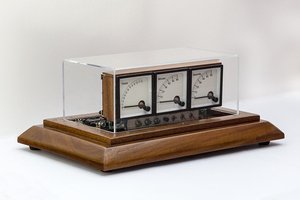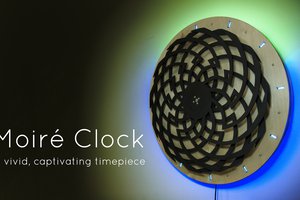DIY ESP8266 Led Matrix Clock Kit
Entry-level DIY kit, designed as fun activity one can complete in one evening
Entry-level DIY kit, designed as fun activity one can complete in one evening
To make the experience fit your profile, pick a username and tell us what interests you.
We found and based on your interests.
When I did this clock project for myself I didn't realize that you'd need to configure time zone settings more than once. But after I start selling those on Tindie few people asked some advice on how to configure time zone without re-flashing firmware.
Although re-flashing LED clock if a good educational exercise, it make perfect sense to allow configuring TZ on the fly, by changing settings via UI. After some thinking I found even better way to approach this.
In the latest version clock will just request timezone settings based on location (and powered by IP geo-location services obviously). I'm still testing the whole flow, but so far it works perfectly.
I did few smaller improvements along the way, mostly to address other issues people contacted me about.
So now if Wifi connection is not available Clock will invite you on the screen to connect to the configuration AP. Also it will sync the clock little more often to pick up daylight saving time changes.
I love my clock ;) I have one just above my desk. Another one in kids bedroom. And another one at my mother's house. One thing that bothered me - absence of a case. I could make a 3D-printed case, but frankly always lacking time to do a good design. I can do some design in an evening, but to make a good design takes much more.
I decided to take a shortcut and order a acrylic case for now. It quite cheap (when ordered in quantities) and it actually looks surprisingly good. Bonus: Now I can keep the clock on the top of my display.
Quick update, as requested by few Tindie customers, clock now available in 3 colors, blue being brightest one, and green most deem.
And more importantly, it can play Game of Life, when it is not too busy being clock!
Latest code as usual at gihub
Make sure that all parts came in good shape and no apparent damage is done on the way.
Disconnect 2 edge led matrix modules from the screen. Be careful not to bend the pins, otherwise it would be a lot of dancing to put them back later on. Don't worry about orientation, they have markings on one side
Solder headers to the Wemos D1 module. Long part of the header should be directed to the motherboard. Make sure to align them right, use motherboard as an aligning tool.
Start with just one pin each side and double check your work. Then you can proceed to other pins
Create an account to leave a comment. Already have an account? Log In.
You can implement alarm if you'd like to. I didn't do it, not a big fan of buzzer alarms myself.
HI Andriy Thanks for the clock module I really love it. I have a question. I connected the clock to my wifi, have changed the time zone and rebuild/uploaded and it is displaying the correct localtime. I now need to move the clock to a new location with a different router. Rebuild/upload leaves the clock looking for the old ssid.I dont seem to be able to connect to the wifi config screen. How do I change the ssid? Thanks Regards Robert
I have built the kit and this is exactly what I was looking for to put in the ham shack. I have left it running for a while with the serial console attached. I am seeing a problem after 24 hours when it tries to get the next NTP update. When it tries to connect, it gets a "Soft WDT reset" (the watch dog timer kicks off). Looking around a bit, I think the issue might be because the WiFi link sets unused for so long. (There are a couple of different places where I saw reference to similar issues and this seemed to be one common theme.) It doesn't take long for it to reset, get the time, and start running (around 15 seconds based on the original time you see set and the time you see set after the the WDT kicks off). I was going to look at doing a single ping to the local gateway once a minute to see if that kind of network keep alive "heartbeat" would help. It isn't that big of a deal, but it is one of those things will be bother me if I don't dig into it a bit. :-)
Hi Jim, I have 3 of those clocks running around the clock and never had this issue. I would assume it would depend on your router and if it will accept device back into the network after long absence, as you described. For the quick fix, I'd set Wifi to be live all the time (if you not running of the batteries, that wouldn't make much difference for you anyway). Wonder it that would fix it.
The WiFi is up the whole time, but some notes I've seen say the ESP8266 has issues sometimes if it goes for a long period (hours) without using WiFi. I did watch things happen today: it freezes (because it was in the middle of scrolling the date just by coincidence) and then resets. On the console I see:
Local time: Tue Mar 21 18:20:49 2023
UTC time: Tue Mar 21 18:20:49 2023
/* Everything above is from yesterday's connect, below starts 24 hours later */
*wm:AutoConnect
*wm:Connecting to SAVED AP: dogiron
*wm:connectTimeout not set, ESP waitForConnectResult...
--------------- CUT HERE FOR EXCEPTION DECODER ---------------
Soft WDT reset
/* There is a stack dump, but the fact is the watch dog timer kicked, so it doesn't mean much. */
It resets after all of that and works just like when it was first powered up. There was only a one or two second pause once it started trying to connect and the WDT going off. That plus the message "connectTimeout not set" makes me wonder if the issue is that the connect timer might need to be longer. I'm going to see what happens if I shorten the period for it to try to sync to see if the problem persists (and would be a little easier to troubleshoot if it was happening once an hour instead of once a day).
Jim, feel free to submit a pull request if you manage to fix it.
Become a member to follow this project and never miss any updates

 brett.oliver
brett.oliver
 mircemk
mircemk
 Henry York
Henry York
 Tamarisk Labs
Tamarisk Labs
This is a great little project! I do have one question, maybe others have run into similar issues? I've changed the firmware a bit (quite easy to do actually with the platformio VScode plugin!) and I am happy with the result. However, what I find is that the clock is *sometimes* off by (exactly) one hour. If I then reset it, it's on time again. Does anyone have a suggestion to what to look into to solve this.
For reference, what I changed: removed blinking and showing of (scrolling) date, turn off clock (the leds) between certain times (i.e., during the night).